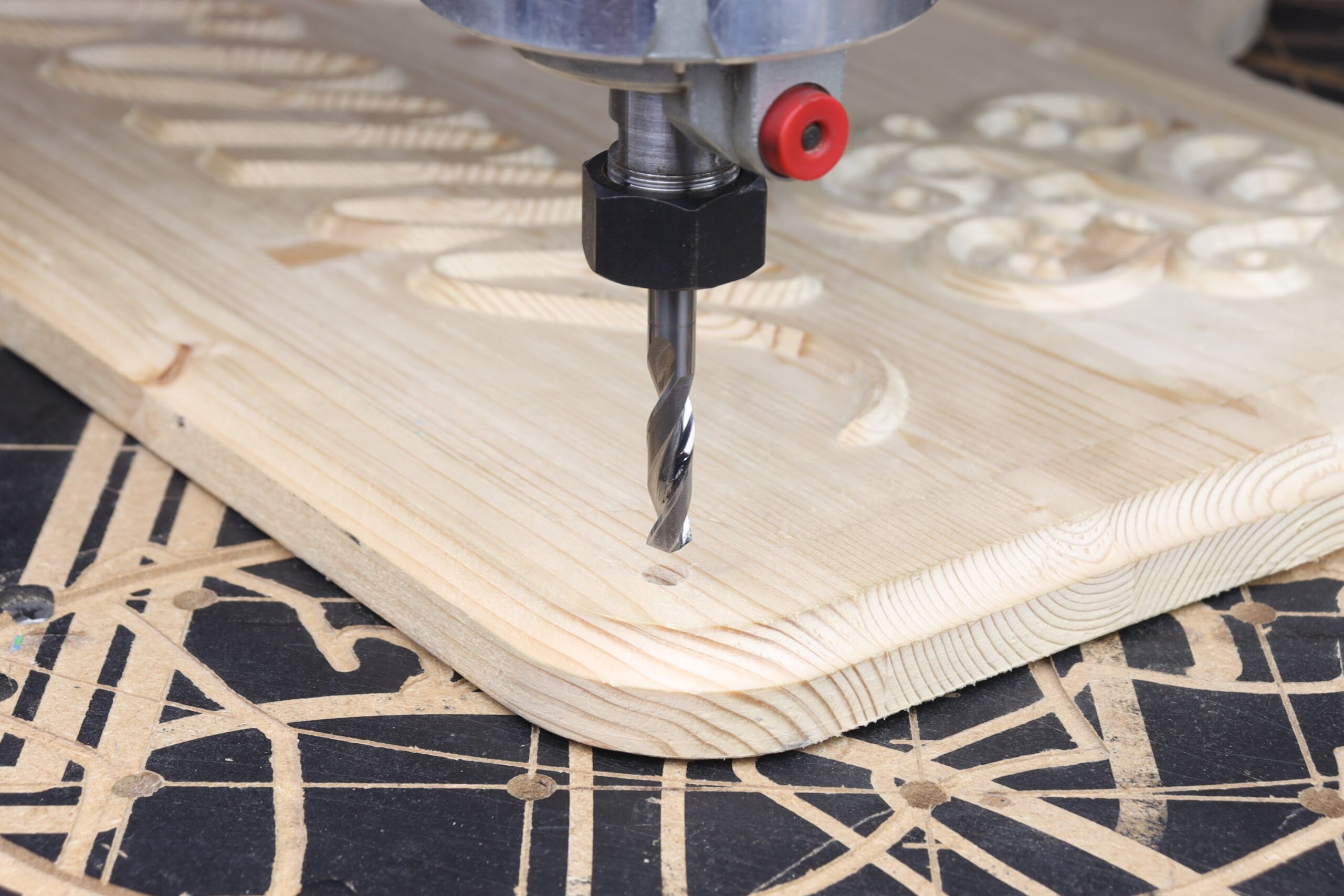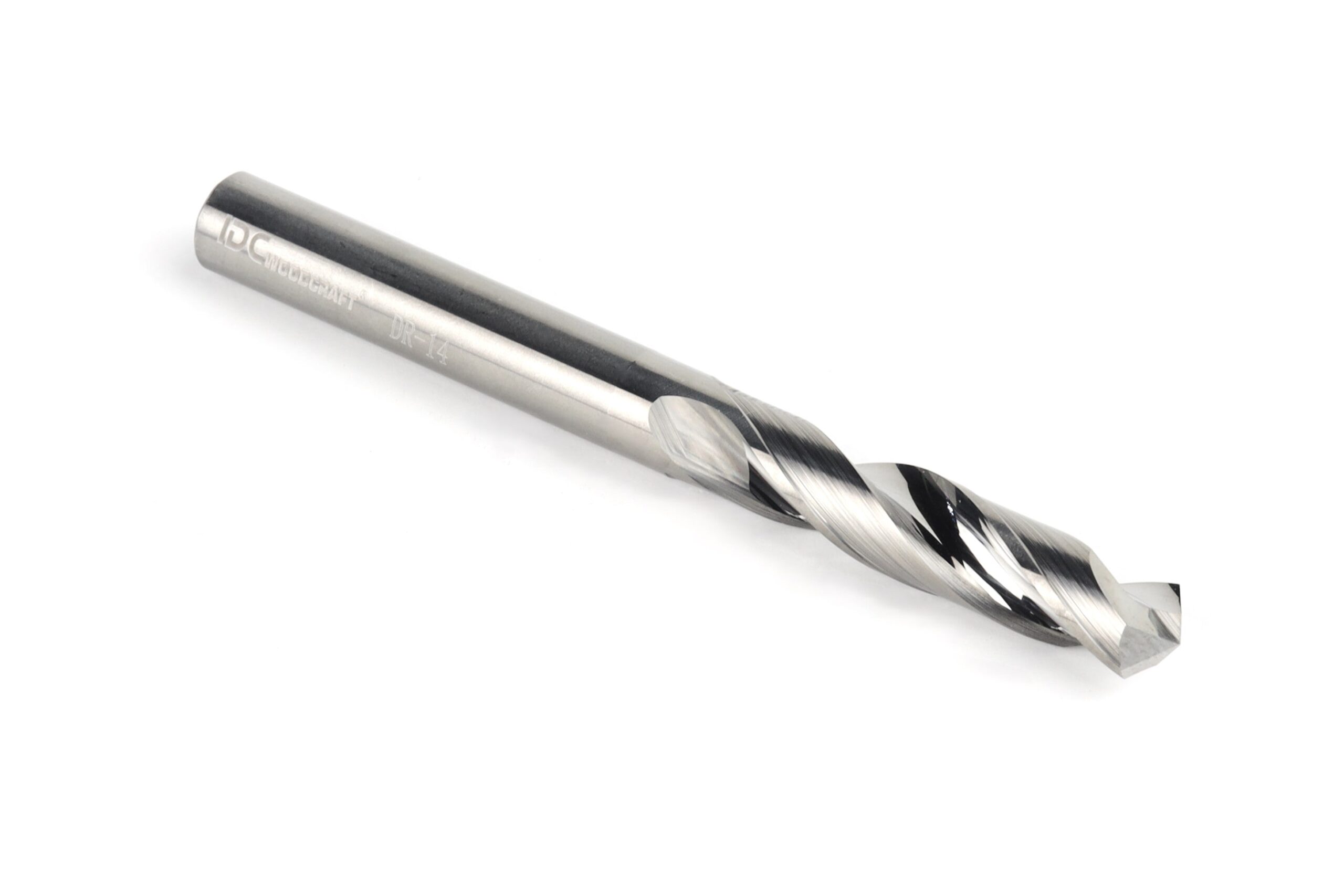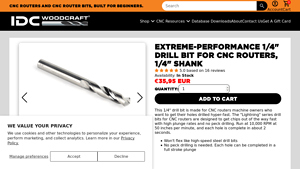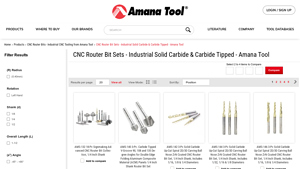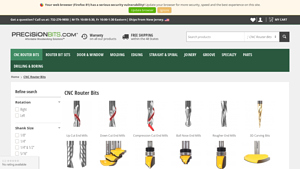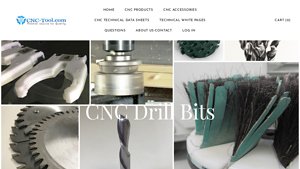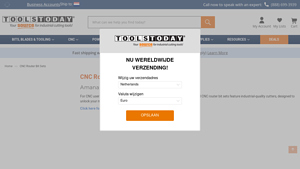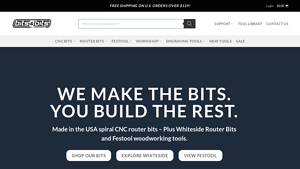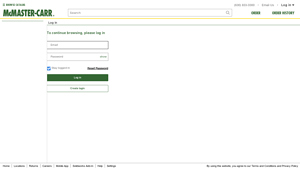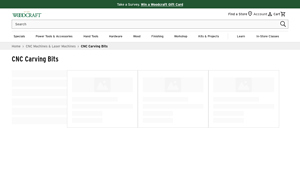Cnc Drill Bits For Wood Guide: Type, Cost, Top List…
Introduction: Navigating the Global Market for cnc drill bits for wood
In the competitive landscape of woodworking, sourcing high-quality CNC drill bits for wood can be a daunting task for international B2B buyers. The challenge lies not just in finding reliable suppliers, but also in understanding the myriad of options available, each tailored to specific applications and materials. This guide serves as a comprehensive resource for navigating the global market, offering insights into various types of CNC drill bits, their applications, and essential factors to consider when selecting the right tools for your business needs.
Within these pages, we will explore the different categories of CNC drill bits, such as up-cut, down-cut, and compression bits, alongside their respective functionalities in wood processing. We will also delve into supplier vetting processes, ensuring that you can identify trustworthy manufacturers and distributors across regions including Africa, South America, the Middle East, and Europe, particularly in countries like Saudi Arabia and Germany. Furthermore, the guide will provide valuable insights into cost considerations and best practices for procurement, empowering you to make informed purchasing decisions.
By equipping you with the knowledge and tools necessary to optimize your sourcing strategy, this guide aims to enhance your operational efficiency and drive profitability in your woodworking endeavors. Whether you’re a seasoned buyer or new to the market, the insights provided here will help you confidently navigate the complexities of sourcing CNC drill bits for wood.
Understanding cnc drill bits for wood Types and Variations
| Type Name | Key Distinguishing Features | Primary B2B Applications | Brief Pros & Cons for Buyers |
|---|---|---|---|
| Up-Cut Spiral Bits | Removes chips upward, ideal for softer woods. | Furniture manufacturing, cabinetry, and signage. | Pros: Excellent chip removal; great for clean finishes. Cons: Can cause splintering on top surface. |
| Down-Cut Spiral Bits | Forces chips downward, minimizing top surface tear-out. | High-quality finish applications, detailed engravings. | Pros: Superior finish on top surfaces; reduces splintering. Cons: Less effective for chip removal. |
| Compression Bits | Combination of up-cut and down-cut features. | Composite materials, plywood, and hardwoods. | Pros: Balanced chip removal; minimizes tear-out on both surfaces. Cons: More expensive than standard bits. |
| Ball Nose Bits | Rounded tip for 3D carving and finishing. | Artistic applications, intricate designs, and mold making. | Pros: Excellent for detailed work; versatile in applications. Cons: Slower cutting speeds; may require more passes. |
| V-Groove Bits | Creates precise V-shaped grooves for decorative work. | Sign making, cabinetry, and decorative projects. | Pros: Ideal for intricate designs; enhances aesthetic appeal. Cons: Limited to specific applications; not suitable for all materials. |
What are Up-Cut Spiral Bits and Their Applications?
Up-cut spiral bits are designed to remove chips upwards, making them particularly effective for softer woods. This type of bit is widely used in furniture manufacturing, cabinetry, and signage production due to its ability to produce clean cuts and effective chip removal. When purchasing, consider the material compatibility and the desired finish quality, as up-cut bits may cause splintering on the top surface of the workpiece.
How Do Down-Cut Spiral Bits Enhance Finish Quality?
Down-cut spiral bits push chips downward, which helps to minimize tear-out on the top surface of the material. This feature makes them ideal for applications where a high-quality finish is paramount, such as detailed engravings and fine woodworking. B2B buyers should evaluate their specific needs in terms of surface quality versus chip removal efficiency when choosing down-cut bits.
What Makes Compression Bits a Versatile Choice?
Compression bits combine the features of both up-cut and down-cut spiral bits, offering balanced chip removal and minimizing tear-out on both surfaces. They are particularly suited for composite materials, plywood, and hardwoods, making them a versatile choice for various applications. However, their higher cost may be a consideration for buyers, especially those operating within tight budget constraints.
Why Choose Ball Nose Bits for Detailed Work?
Ball nose bits feature a rounded tip that is ideal for 3D carving and finishing applications. They excel in artistic projects, intricate designs, and mold-making tasks, providing excellent detail and versatility. Buyers should consider the cutting speeds, as ball nose bits may require slower feed rates and multiple passes to achieve the desired depth and detail.
What Are the Benefits of Using V-Groove Bits?
V-groove bits are specialized tools designed to create precise V-shaped grooves, making them ideal for decorative work in sign making and cabinetry. They enhance the aesthetic appeal of projects by allowing for intricate designs. However, their application is somewhat limited, and buyers should assess whether their specific projects will benefit from this specialized functionality before making a purchase.
Key Industrial Applications of cnc drill bits for wood
| Industry/Sector | Specific Application of cnc drill bits for wood | Value/Benefit for the Business | Key Sourcing Considerations for this Application |
|---|---|---|---|
| Furniture Manufacturing | Precision drilling for joinery and assembly | Enhanced product quality and reduced assembly time | Material compatibility, bit durability, and precision standards |
| Cabinetry | Drilling holes for hinges, shelves, and fittings | Improved accuracy and efficiency in production processes | Bit geometry, coating options, and compatibility with CNC machines |
| Construction | Creating custom wooden structures and frameworks | Cost savings through reduced waste and faster production | Sourcing from reliable manufacturers, bulk purchasing options |
| Craft and Hobby | Fine detail drilling for artistic projects | Ability to create intricate designs and custom pieces | Variety of bit sizes, user-friendly options, and support services |
| Woodworking Education | Teaching CNC techniques with practical applications | Skill development and hands-on learning experiences | Availability of educational kits and support materials |
How Are CNC Drill Bits for Wood Used in Furniture Manufacturing?
In the furniture manufacturing sector, CNC drill bits for wood are essential for precision drilling in joinery and assembly processes. These bits enable manufacturers to create accurate holes for dowels, screws, and other fasteners, ensuring that components fit together seamlessly. The use of high-quality drill bits reduces the risk of material damage and enhances the overall quality of the finished product. For international buyers, sourcing bits that are compatible with various wood types and CNC machinery is crucial to maintaining production efficiency and product integrity.
What is the Role of CNC Drill Bits in Cabinetry?
CNC drill bits are extensively used in cabinetry for drilling holes for hinges, shelves, and various fittings. The precision offered by these bits allows for consistent hole placement, which is vital for the structural integrity and functionality of cabinets. Businesses benefit from increased production speed and reduced labor costs due to the automation of drilling processes. Buyers should consider the specific geometries and coatings of drill bits to match the materials they work with, ensuring optimal performance and longevity.
How Do CNC Drill Bits Enhance Construction Applications?
In the construction industry, CNC drill bits for wood are utilized to create custom wooden structures and frameworks, such as beams and trusses. These bits help in achieving precise dimensions and angles, which are critical for structural stability. By using CNC technology, construction companies can minimize material waste and expedite their building processes. When sourcing bits for construction applications, businesses should prioritize durability and the ability to handle various wood densities, ensuring they can meet diverse project requirements.
How Are CNC Drill Bits Beneficial for Craft and Hobby Projects?
For craft and hobbyists, CNC drill bits for wood are invaluable for executing fine detail drilling in artistic projects. These bits allow creators to produce intricate designs, custom pieces, and personalized gifts. The versatility of CNC drill bits enables hobbyists to work with different types of wood and project scales. Buyers in this sector should look for bits that offer a range of sizes and shapes, as well as options that are easy to use, to enhance their crafting experience.
Why Are CNC Drill Bits Important in Woodworking Education?
In woodworking education, CNC drill bits are used to teach students practical CNC techniques through hands-on projects. These drill bits facilitate the learning of precision machining and design principles, enabling students to create functional and artistic wooden items. Educational institutions benefit from sourcing CNC drill bits that are durable and provide consistent performance, as this fosters a conducive learning environment. Availability of educational kits that include various bit types and sizes can further enhance the training experience for students.
3 Common User Pain Points for ‘cnc drill bits for wood’ & Their Solutions
Scenario 1: Ensuring Consistent Quality in Woodworking Projects
The Problem: B2B buyers often grapple with the inconsistency of quality when sourcing CNC drill bits for wood. In regions like Africa and South America, where local suppliers may not have robust quality control measures, the risk of receiving subpar products increases. This inconsistency can lead to issues such as uneven cuts, premature wear, and ultimately, the need for costly rework. Such challenges not only disrupt production schedules but also affect the overall quality of finished goods, damaging a company’s reputation.
The Solution: To mitigate these risks, B2B buyers should prioritize sourcing CNC drill bits from reputable suppliers with proven track records. Conducting thorough research is vital—look for manufacturers that provide detailed specifications and user reviews. Additionally, consider investing in drill bits made from premium materials, such as solid carbide or carbide-tipped options, which are known for their durability and superior cutting performance. Implementing a quality assurance process, such as conducting a pre-purchase sample test, can also help ensure that the bits meet the necessary standards before placing larger orders.
Scenario 2: Managing Inventory and Supply Chain Disruptions
The Problem: Many businesses face inventory challenges, particularly when demand for CNC drill bits fluctuates. Buyers in the Middle East and Europe, for instance, may experience delays due to shipping constraints or unexpected spikes in demand during peak seasons. This can lead to project delays and increased operational costs, as businesses scramble to find last-minute replacements or alternative suppliers.
The Solution: Implementing a just-in-time (JIT) inventory management system can help mitigate supply chain disruptions. By analyzing past usage patterns, businesses can forecast their CNC drill bit requirements more accurately. Additionally, establishing relationships with multiple suppliers can provide backup options in case of shortages. Collaborating with suppliers to set up automatic reorder points based on inventory levels can also streamline the procurement process, ensuring that the necessary drill bits are always available without overstocking.
Scenario 3: Selecting the Right Type of CNC Drill Bit for Specific Applications
The Problem: B2B buyers often struggle with selecting the appropriate type of CNC drill bit for specific woodworking applications. With a vast array of options—such as up-cut, down-cut, compression, and specialty bits—making the right choice can be overwhelming. Incorrect selections can lead to poor machining results, such as tear-out, inadequate chip removal, or even damage to the workpiece.
The Solution: To effectively navigate this challenge, buyers should invest time in understanding the different types of CNC drill bits and their specific applications. A well-structured selection guide can be invaluable; it should include factors like wood type, desired finish quality, and the specific machining process being used. Additionally, consulting with technical experts or engaging in training sessions offered by suppliers can enhance understanding. It’s also beneficial to maintain an inventory that includes a range of bits for different applications, allowing for flexibility in production processes. When testing new bits, documenting performance metrics can guide future purchasing decisions and help refine the selection process.
Strategic Material Selection Guide for cnc drill bits for wood
What Are the Key Materials for CNC Drill Bits for Wood?
When selecting CNC drill bits for wood, the material of the bit plays a crucial role in determining its performance, durability, and suitability for specific applications. Here, we analyze four common materials used in the manufacturing of CNC drill bits for wood, focusing on their properties, advantages, disadvantages, and considerations for international B2B buyers.
How Does Solid Carbide Perform in CNC Drill Bits for Wood?
Solid carbide is a popular choice for CNC drill bits due to its exceptional hardness and wear resistance. It typically withstands high temperatures and maintains sharpness longer than other materials, making it ideal for precision woodworking applications. However, solid carbide bits can be brittle, which may lead to chipping or breaking under excessive lateral pressure.
Pros:
– High durability and longevity.
– Excellent cutting performance at high speeds.
Cons:
– Higher initial cost compared to other materials.
– More susceptible to breakage if mishandled.
For international buyers, especially in regions like Europe and the Middle East, compliance with standards such as DIN for tool manufacturing is essential. Solid carbide bits are often preferred for high-end applications where precision is paramount.
What Are the Benefits of High-Speed Steel (HSS) for CNC Drill Bits?
High-speed steel (HSS) is another common material for CNC drill bits, known for its good balance of hardness and toughness. HSS bits can endure high temperatures without losing their temper, making them suitable for various woodworking tasks. They are generally less expensive than solid carbide bits, making them a cost-effective option for many businesses.
Pros:
– Cost-effective and versatile.
– Good resistance to heat.
Cons:
– Shorter lifespan compared to solid carbide.
– Less effective at high speeds.
International buyers should consider the availability of HSS bits in their local markets, as well as any certifications that may be necessary for their specific applications. HSS is widely accepted across various standards, making it a reliable choice.
Why Choose Cobalt Steel for CNC Drill Bits?
Cobalt steel bits are an enhanced version of HSS, containing a percentage of cobalt that improves their heat resistance and durability. This material is particularly beneficial for drilling hardwoods, where heat buildup can be a concern. Cobalt bits maintain their sharpness longer than standard HSS, making them suitable for demanding applications.
Pros:
– Superior heat resistance and durability.
– Longer tool life compared to standard HSS.
Cons:
– Higher cost than regular HSS.
– More complex manufacturing process.
For B2B buyers in regions like South America and Africa, cobalt bits may be less commonly available, and sourcing them might require additional effort. Compliance with local standards and certifications should also be verified.
What Is the Role of Coated Bits in CNC Applications?
Coated drill bits, often made from HSS or carbide and treated with coatings such as titanium nitride (TiN) or zirconium nitride (ZrN), enhance performance by reducing friction and improving wear resistance. These coatings allow for better heat dissipation, making them ideal for high-speed operations.
Pros:
– Increased lifespan due to reduced friction.
– Enhanced performance in high-speed applications.
Cons:
– Coating can wear off over time.
– Generally more expensive than uncoated bits.
International buyers should ensure that the coatings used comply with local regulations, particularly in Europe, where environmental standards may dictate the types of coatings permissible for use.
Summary Table of Material Selection for CNC Drill Bits
| Material | Typical Use Case for CNC Drill Bits for Wood | Key Advantage | Key Disadvantage/Limitation | Relative Cost (Low/Med/High) |
|---|---|---|---|---|
| Solid Carbide | Precision woodworking and detailed cuts | High durability and longevity | Brittle; can chip under lateral pressure | High |
| High-Speed Steel | General woodworking and versatile applications | Cost-effective and versatile | Shorter lifespan than solid carbide | Medium |
| Cobalt Steel | Drilling hardwoods and demanding applications | Superior heat resistance and durability | Higher cost and complex manufacturing | High |
| Coated Bits | High-speed operations and enhanced performance | Increased lifespan and performance | Coating can wear off; higher initial cost | Medium to High |
In conclusion, selecting the right material for CNC drill bits for wood involves evaluating the specific needs of the application, considering cost implications, and ensuring compliance with regional standards. By understanding the properties and performance characteristics of each material, international B2B buyers can make informed decisions that enhance their operational efficiency.
In-depth Look: Manufacturing Processes and Quality Assurance for cnc drill bits for wood
What Are the Main Stages in the Manufacturing Process of CNC Drill Bits for Wood?
The manufacturing of CNC drill bits for wood involves several critical stages that ensure the final product meets the necessary performance standards. The process typically includes material preparation, forming, assembly, and finishing.
Material Preparation
The first step in the manufacturing process is selecting high-quality materials. Most CNC drill bits are made from solid carbide or high-speed steel (HSS). These materials are chosen for their durability and ability to retain sharpness over time. The materials undergo a rigorous quality check to confirm they meet specifications before being cut into pre-defined lengths and shapes.
Forming Techniques: How Are CNC Drill Bits Shaped?
Once the materials are prepared, the next stage is forming. This involves various machining techniques, including grinding, milling, and turning. Precision grinding is especially important for creating the cutting edges of the drill bits. Advanced CNC machines are utilized to achieve the exact angles and profiles required for effective wood drilling.
Additionally, some manufacturers employ techniques like coating the bits with titanium nitride (TiN) or zirconium nitride (ZrN) to enhance their hardness and reduce friction during use. This coating process is typically applied after the bits are formed but before finishing.
Assembly: How Are CNC Drill Bits Constructed?
Following the forming process, assembly takes place. This stage may involve attaching shanks to the bits or incorporating additional features such as chip breakers or flutes. The assembly process is conducted under strict quality control to ensure that all components fit precisely and function as intended.
Finishing: What Treatments Are Applied to CNC Drill Bits?
Finishing treatments are applied to enhance the bits’ performance and longevity. This can include polishing, additional coating, and quality checks for sharpness and dimensional accuracy. The finishing stage is critical, as it directly impacts the efficiency and lifespan of the drill bits in various wood applications.
What Quality Assurance Measures Are Commonly Implemented in CNC Drill Bit Manufacturing?
Quality assurance (QA) is a fundamental component of the manufacturing process, ensuring that products meet international standards and customer expectations.
What International Standards Should B2B Buyers Look For?
B2B buyers should look for compliance with international standards such as ISO 9001, which outlines criteria for a quality management system. This certification indicates that the manufacturer has established a robust framework for quality assurance throughout the manufacturing process. Additionally, certifications like CE mark and API standards may also apply, depending on the specific applications of the CNC drill bits.
What Are the Key Quality Control Checkpoints in the Manufacturing Process?
Quality control checkpoints are essential for identifying defects or inconsistencies. Common checkpoints include:
- Incoming Quality Control (IQC): This stage verifies the quality of raw materials before they enter the manufacturing process.
- In-Process Quality Control (IPQC): This involves monitoring manufacturing processes to ensure they comply with specifications and tolerances.
- Final Quality Control (FQC): After finishing, the drill bits undergo a final inspection to confirm they meet all quality standards before shipment.
How Are Common Testing Methods Used to Ensure Product Quality?
Several testing methods are employed to verify the quality of CNC drill bits for wood. These may include:
- Dimensional Inspection: Ensures that the bits meet specified tolerances for length, diameter, and angles.
- Hardness Testing: Measures the hardness of the bits to ensure they can withstand prolonged use without dulling.
- Performance Testing: Involves actual drilling tests to evaluate the efficiency and effectiveness of the bits in various wood types.
How Can B2B Buyers Verify Supplier Quality Control?
B2B buyers should take proactive steps to verify the quality control measures of potential suppliers. Here are some strategies to consider:
- Supplier Audits: Conducting on-site audits allows buyers to observe the manufacturing process and QA practices in action. This can provide insights into the supplier’s commitment to quality.
- Requesting Quality Reports: Suppliers should provide documentation detailing their QA processes, including results from IQC, IPQC, and FQC stages.
- Third-Party Inspections: Engaging a third-party inspection service can provide an unbiased assessment of the supplier’s quality control measures and product quality.
What Are the Quality Control and Certification Nuances for International B2B Buyers?
International buyers, particularly those in regions such as Africa, South America, the Middle East, and Europe, should be aware of specific nuances in quality control and certification. Different markets may have varying expectations and regulations regarding product quality.
- Regional Standards Compliance: Ensure that the supplier adheres to both international standards and any specific regional regulations that may apply in your market.
- Documentation and Traceability: Maintain clear documentation of all quality certifications and inspection reports to facilitate customs clearance and compliance with local regulations.
- Cultural Considerations: Understanding cultural differences in business practices can also influence the supplier relationship and communication regarding quality assurance.
Conclusion: Ensuring Quality in CNC Drill Bits Manufacturing
In conclusion, understanding the manufacturing processes and quality assurance measures for CNC drill bits for wood is essential for B2B buyers. By focusing on the main stages of production, relevant international standards, and effective verification methods, buyers can make informed decisions that align with their quality expectations and operational needs. This proactive approach not only enhances procurement efficiency but also fosters long-term partnerships with reliable suppliers.
Practical Sourcing Guide: A Step-by-Step Checklist for ‘cnc drill bits for wood’
In the competitive landscape of B2B procurement, sourcing CNC drill bits for wood requires a strategic approach. This guide provides a step-by-step checklist designed to streamline your purchasing process, ensuring you make informed decisions that align with your operational needs and quality standards.
Step 1: Define Your Technical Specifications
Before you start searching for suppliers, clearly outline the technical specifications required for your CNC drill bits. This includes parameters like shank size, cutting diameter, flute count, and material type (e.g., solid carbide or carbide-tipped). Knowing these details will help you communicate effectively with suppliers and ensure you receive products that meet your manufacturing needs.
Step 2: Research and Identify Potential Suppliers
Begin by researching suppliers who specialize in CNC drill bits for wood. Look for manufacturers and distributors with a proven track record in your target regions, such as Africa, South America, the Middle East, and Europe. Utilize online directories, industry trade shows, and networking opportunities to compile a list of potential partners.
Step 3: Evaluate Supplier Certifications
It’s essential to verify that potential suppliers hold relevant industry certifications, such as ISO 9001 or equivalent. These certifications indicate that the supplier adheres to international quality management standards, ensuring that the products you receive will meet your quality expectations. Request documentation and ask about their quality control processes.
Step 4: Request Samples for Testing
Before finalizing your order, request samples of the CNC drill bits you intend to purchase. Testing samples allows you to evaluate the performance, durability, and compatibility of the bits with your machinery. Look for factors such as cutting efficiency and finish quality during your tests to make an informed decision.
Step 5: Assess Pricing and Payment Terms
Once you have evaluated the quality of the products, compare pricing among your shortlisted suppliers. Consider not just the upfront costs, but also any potential discounts for bulk purchases and the overall value offered. Additionally, clarify payment terms, including deposits, credit options, and any other financial considerations that could impact your cash flow.
Step 6: Examine Shipping and Logistics Options
Shipping logistics can significantly affect lead times and costs. Confirm that your chosen supplier can meet your delivery timelines, particularly if you operate in regions with specific logistical challenges. Inquire about shipping methods, costs, and whether they offer tracking capabilities to monitor your order.
Step 7: Establish a Long-Term Relationship
Once you’ve selected a supplier, focus on building a long-term relationship. Regular communication and feedback can lead to better service, tailored solutions, and potentially favorable pricing in the future. Consider setting up periodic reviews to assess product performance and explore opportunities for collaboration on new product development.
By following this checklist, you can navigate the procurement process for CNC drill bits for wood more effectively, ensuring that your purchasing decisions are well-informed and aligned with your business goals.
Comprehensive Cost and Pricing Analysis for cnc drill bits for wood Sourcing
Understanding the cost structure and pricing dynamics of CNC drill bits for wood is crucial for international B2B buyers seeking cost-effective sourcing solutions.
What Are the Key Cost Components in CNC Drill Bits for Wood Manufacturing?
When analyzing the cost structure of CNC drill bits, several components come into play:
-
Materials: The type of materials used significantly influences the cost. Solid carbide and carbide-tipped bits are common choices, with solid carbide typically commanding a higher price due to its durability and performance. The choice of coating (e.g., ZrN, AlTiN) also affects costs, as specialized coatings enhance tool longevity and cutting efficiency.
-
Labor: Labor costs vary by region and production scale. In high-wage countries, labor costs may represent a significant portion of the overall cost. Efficient manufacturing processes can mitigate these expenses, making it essential to choose suppliers with optimized production capabilities.
-
Manufacturing Overhead: This includes expenses related to machinery maintenance, facility costs, and utilities. Suppliers with advanced manufacturing technologies may have higher initial investments but can offer better pricing through efficiency gains.
-
Tooling: The initial cost of tooling can be substantial, especially for custom or high-precision bits. Suppliers often amortize these costs over production runs, which can influence the pricing structure based on order volume.
-
Quality Control (QC): Rigorous QC processes ensure product reliability but can also add to costs. Certifications and compliance with international standards (e.g., ISO) may be necessary, especially for buyers in regulated markets.
-
Logistics: Shipping and handling costs can vary significantly based on the shipping terms (Incoterms) agreed upon. International shipping, tariffs, and import duties must be factored into the total cost.
-
Margin: Suppliers typically add a margin to cover their risks and desired profit. This margin can fluctuate based on market demand and competition, impacting the final price to buyers.
How Do Pricing Influencers Affect CNC Drill Bits for Wood Costs?
Several factors influence the pricing of CNC drill bits:
-
Volume and Minimum Order Quantity (MOQ): Higher order volumes often lead to lower per-unit costs due to economies of scale. Buyers should negotiate MOQs that align with their operational needs to maximize cost efficiency.
-
Specifications and Customization: Custom-designed bits or specific specifications can lead to increased costs. Buyers should assess whether standard products can meet their needs before opting for customization.
-
Material Quality and Certifications: Higher-quality materials and certifications usually mean higher costs but can lead to lower total costs over time due to reduced wear and tear.
-
Supplier Factors: The reputation, reliability, and location of suppliers can influence pricing. Suppliers with a robust track record may charge a premium, but the assurance of quality can justify the higher cost.
-
Incoterms: Understanding shipping terms is essential for managing costs. Choosing the right Incoterm can help buyers avoid unexpected fees and streamline logistics.
What Buyer Tips Can Enhance Cost Efficiency in Sourcing CNC Drill Bits?
-
Negotiation Strategies: Buyers should engage suppliers in discussions about pricing, especially for bulk orders. Understanding the supplier’s cost structure can provide leverage during negotiations.
-
Consider Total Cost of Ownership: Evaluate not just the purchase price but the overall lifecycle costs, including durability, maintenance, and potential downtime. Investing in higher-quality bits may yield savings over time.
-
Pricing Nuances for International Buyers: When sourcing from different regions, be aware of currency fluctuations, import duties, and shipping costs that can impact pricing. Building relationships with suppliers in key regions can lead to more favorable terms.
-
Stay Informed on Market Trends: Regularly monitoring market trends and competitor offerings can provide insights into pricing shifts and help in making informed purchasing decisions.
Disclaimer
Prices mentioned in this analysis are indicative and subject to change based on market conditions, supplier negotiations, and buyer-specific factors. Always consult with suppliers for the most accurate and up-to-date pricing information.
Alternatives Analysis: Comparing cnc drill bits for wood With Other Solutions
Exploring Alternatives to CNC Drill Bits for Wood: A Comparative Analysis
In the manufacturing and woodworking industries, selecting the right tools is crucial for achieving efficiency, precision, and cost-effectiveness. While CNC drill bits for wood are a popular choice for many applications, various alternatives can also fulfill similar roles. This analysis will compare CNC drill bits with two viable alternatives: Laser Cutting Technology and Traditional Hand Tools.
Comparison Table
| Comparison Aspect | CNC Drill Bits for Wood | Laser Cutting Technology | Traditional Hand Tools |
|---|---|---|---|
| Performance | High precision; suitable for complex designs | Extremely precise; best for intricate shapes and fine details | Moderate precision; depends on the skill of the user |
| Cost | Moderate initial investment; variable based on quality | Higher initial cost; long-term savings on material waste | Low initial cost; costs increase with tool maintenance |
| Ease of Implementation | Requires CNC machine setup and programming | Requires specialized equipment and software | Simple to use; no setup required, but skill-dependent |
| Maintenance | Regular sharpening and replacement needed | Minimal maintenance; software updates required | Frequent maintenance; depends on usage |
| Best Use Case | Mass production and complex designs | High-precision cuts and intricate designs | Craftsmanship, repairs, and detailed work |
Detailed Breakdown of Alternatives
Laser Cutting Technology
Laser cutting has emerged as a sophisticated alternative to CNC drill bits for wood. This technology uses focused laser beams to cut materials with high precision, making it ideal for intricate designs and detailed work. The primary advantage of laser cutting is its ability to produce clean edges without the need for post-processing. However, the initial investment in laser cutting machines can be substantial, and the technology requires specialized knowledge for operation. Additionally, while maintenance is generally low, software updates and occasional calibration are necessary to ensure optimal performance.
Traditional Hand Tools
Traditional hand tools, such as chisels, saws, and drills, represent a time-tested approach to woodworking. These tools are often more affordable than their CNC counterparts and allow for a high degree of craftsmanship and personalization. The main advantage of hand tools is their accessibility; they require minimal setup and can be used anywhere. However, the precision of cuts and designs heavily depends on the skill of the user, and achieving uniform results can be challenging. Maintenance is also a factor, as tools must be kept sharp and in good condition to perform effectively.
Conclusion: Making the Right Choice for Your Business Needs
When selecting the right solution for woodworking applications, B2B buyers should consider their specific needs, including the scale of production, the complexity of designs, and budget constraints. CNC drill bits for wood excel in high-volume production and intricate designs, while laser cutting technology offers unmatched precision for detailed work. Traditional hand tools, on the other hand, provide flexibility and craftsmanship at a lower cost. Ultimately, the decision should be guided by an assessment of operational requirements, cost-effectiveness, and the desired quality of the finished product. By understanding the strengths and weaknesses of each option, buyers can make informed choices that align with their business objectives.
Essential Technical Properties and Trade Terminology for cnc drill bits for wood
What Are the Key Technical Properties of CNC Drill Bits for Wood?
When selecting CNC drill bits for wood, understanding specific technical properties is vital for ensuring optimal performance, durability, and cost-effectiveness. Here are several critical specifications to consider:
-
Material Grade
The material from which the drill bits are made significantly affects their performance. Common materials include high-speed steel (HSS) and solid carbide. HSS offers a balance of toughness and sharpness, making it suitable for softer woods, while solid carbide provides superior durability and precision for harder woods. Choosing the right material grade can lead to longer tool life and reduced downtime, which is crucial for maintaining production schedules. -
Flute Design
The design of the flutes (the grooves along the bit) impacts chip removal and cutting efficiency. Standard options include up-cut, down-cut, and compression flutes. Up-cut flutes pull chips upward, which can be beneficial for clearing debris but may cause splintering. Down-cut flutes push chips downward, providing cleaner cuts on the surface. Compression flutes combine both designs, minimizing surface tearing. Understanding flute design helps buyers choose bits that align with their specific wood applications and desired finish quality. -
Shank Size
The shank size, typically measured in inches (e.g., 1/4″, 1/2″), determines compatibility with CNC machines. A larger shank may provide better stability and less vibration, which is essential for achieving precise cuts. Buyers should ensure that the shank size matches their CNC equipment to avoid operational issues. -
Cutting Diameter
The cutting diameter affects the hole size and the overall application versatility of the drill bit. Standard sizes range from 1/32″ to 1″. Selecting the appropriate diameter is crucial for achieving the desired hole size while maintaining the integrity of the wood material. It’s important for buyers to consider the specific requirements of their projects when choosing cutting diameters. -
Coating Options
Coatings such as titanium nitride (TiN) or zirconium nitride (ZrN) enhance the performance of CNC drill bits by reducing friction and increasing wear resistance. These coatings can also improve chip flow and prolong the tool’s lifespan. Buyers should assess the types of wood and the anticipated production volume to determine whether coated bits are a worthwhile investment.
Which Trade Terminology Should B2B Buyers Understand for CNC Drill Bits?
Navigating the purchasing process for CNC drill bits involves familiarity with specific industry terms. Here are key trade terminologies that buyers should know:
-
OEM (Original Equipment Manufacturer)
This term refers to companies that produce parts or equipment that may be marketed by another manufacturer. In the context of CNC drill bits, understanding OEM relationships can help buyers identify reputable suppliers who produce high-quality products. -
MOQ (Minimum Order Quantity)
MOQ specifies the smallest quantity a supplier is willing to sell. This is crucial for budget-conscious buyers or those testing new products. Knowing the MOQ helps in planning inventory and ensuring that bulk purchases do not exceed the company’s immediate needs. -
RFQ (Request for Quotation)
An RFQ is a document sent to suppliers requesting pricing and terms for specific products. This process allows buyers to compare costs and services among different suppliers, facilitating informed purchasing decisions. -
Incoterms (International Commercial Terms)
These are standardized trade terms used in international transactions that define the responsibilities of buyers and sellers. Familiarity with Incoterms is essential for understanding shipping costs, risk management, and delivery obligations, particularly for international buyers. -
Lead Time
Lead time refers to the amount of time it takes from placing an order to receiving the product. Understanding lead times is critical for production planning, especially in industries that operate on tight schedules.
By grasping these technical properties and trade terminologies, B2B buyers can make more informed decisions when sourcing CNC drill bits for wood, ultimately enhancing their operational efficiency and product quality.
Navigating Market Dynamics and Sourcing Trends in the cnc drill bits for wood Sector
What Are the Current Market Dynamics and Key Trends in the CNC Drill Bits for Wood Sector?
The CNC drill bits for wood market is experiencing significant growth, driven by the increasing demand for precision machining in woodworking applications. Globally, factors such as the rise of automated manufacturing processes, the proliferation of CNC technology, and the growing trend towards personalized woodworking products are reshaping the landscape. Particularly in regions like Africa, South America, the Middle East, and Europe, international B2B buyers are increasingly seeking high-quality, durable drill bits that can withstand rigorous machining demands while offering versatility for various wood types.
Emerging trends include the integration of advanced materials, such as solid carbide and carbide-tipped bits, which enhance durability and performance. Additionally, the market is witnessing a shift towards customized bit sets tailored for specific applications, allowing buyers to optimize their machining processes. The rise of e-commerce platforms is also transforming sourcing practices, enabling buyers to access a broader range of products and suppliers, facilitating comparisons, and streamlining procurement processes.
Moreover, the global push for Industry 4.0 is influencing the CNC drill bits market, with buyers looking for tools that can integrate seamlessly with their CNC machinery. As manufacturers innovate, there’s an increasing focus on producing bits that minimize waste and improve efficiency, which is particularly relevant for markets in developing regions where resource optimization is critical.
How Is Sustainability Influencing Sourcing Practices in the CNC Drill Bits for Wood Sector?
Sustainability has become a crucial consideration in the sourcing of CNC drill bits for wood. The environmental impact of manufacturing processes and the materials used in these products are under scrutiny, prompting B2B buyers to prioritize ethical sourcing. Buyers are increasingly looking for suppliers who adhere to sustainable practices, including responsible sourcing of raw materials and minimizing waste during production.
The demand for ‘green’ certifications is rising, with buyers favoring products made from eco-friendly materials or those that have undergone environmentally responsible manufacturing processes. Certifications such as FSC (Forest Stewardship Council) or PEFC (Programme for the Endorsement of Forest Certification) are becoming vital for suppliers aiming to appeal to conscious buyers. Additionally, companies are exploring the use of recycled materials in the production of drill bits, aligning with the global shift towards a circular economy.
By adopting sustainable sourcing practices, businesses can not only reduce their environmental footprint but also enhance their brand reputation and appeal to a growing segment of eco-conscious consumers. This trend is particularly important in Europe, where regulatory frameworks often demand stricter compliance with environmental standards.
What Is the Evolution of CNC Drill Bits for Wood and Its Significance for B2B Buyers?
The evolution of CNC drill bits for wood can be traced back to the early days of woodworking machinery, where simple hand tools dominated. As the industry progressed, the introduction of CNC technology revolutionized the way wood was machined, leading to the development of specialized drill bits designed for precision and efficiency. Over the years, advancements in materials science have resulted in the creation of more robust and versatile bits, such as solid carbide options that offer superior wear resistance and cutting performance.
The significance of this evolution for B2B buyers lies in the enhanced capabilities of modern drill bits, which allow for more intricate designs and faster production times. Today’s CNC drill bits are engineered to cater to a diverse range of woodworking applications, from simple cuts to complex carvings, enabling businesses to meet customer demands for customization and quality. This historical context underscores the importance of selecting the right drill bits, as their performance directly impacts production efficiency and overall product quality in woodworking operations.
Frequently Asked Questions (FAQs) for B2B Buyers of cnc drill bits for wood
-
How do I select the right CNC drill bits for woodworking projects?
Choosing the right CNC drill bits for woodworking involves considering the type of wood, desired finish, and the specific application. For instance, up-cut bits are excellent for chip removal and creating clean edges, while down-cut bits provide a smoother finish on the top surface. Additionally, the diameter and flute count will affect the cut quality and speed. It’s advisable to consult with suppliers about the best options based on your machine specifications and project requirements to ensure optimal performance. -
What is the best material for CNC drill bits used in woodworking?
The best materials for CNC drill bits in woodworking typically include high-speed steel (HSS) and carbide. HSS bits are suitable for softer woods and general applications, offering a balance of cost and durability. Carbide bits, while more expensive, provide superior longevity and performance, particularly in harder woods or high-volume production settings. When sourcing, consider the specific wood types you work with to determine the most effective material for your needs. -
What should I look for when vetting international suppliers for CNC drill bits?
When vetting international suppliers, assess their reputation, product quality, and compliance with international standards. Request samples to evaluate the performance of their drill bits. Additionally, check for certifications such as ISO or similar quality assurance markers. Establish clear communication channels and verify their experience in exporting to your region. Reviews and testimonials from other B2B buyers can also provide insight into their reliability and service quality. -
What are the typical minimum order quantities (MOQs) for CNC drill bits?
Minimum order quantities (MOQs) for CNC drill bits can vary significantly between suppliers, often ranging from 50 to 100 units. Some manufacturers may offer lower MOQs for custom orders, while others might require higher quantities to ensure cost-effectiveness. It is essential to discuss MOQs upfront to align with your procurement strategy and avoid overcommitting to inventory that may not be necessary. -
What payment terms are commonly offered for international purchases of CNC drill bits?
Common payment terms for international purchases of CNC drill bits include options like upfront payment, 30% deposit with the balance upon delivery, or net 30/60 days after receipt of goods. It’s crucial to negotiate terms that suit your cash flow while ensuring supplier security. Using secure payment methods such as letters of credit or escrow services can also mitigate risks associated with international transactions. -
How can I ensure quality assurance for CNC drill bits sourced internationally?
To ensure quality assurance when sourcing CNC drill bits internationally, establish clear specifications and performance standards with your supplier. Request certifications that verify their manufacturing processes meet industry standards. Conduct regular quality checks and consider third-party inspections before shipment. Building a solid relationship with your supplier can also facilitate better quality control and communication regarding any issues that may arise. -
What logistics considerations should I keep in mind when importing CNC drill bits?
Logistics considerations for importing CNC drill bits include shipping methods, customs clearance, and delivery timelines. Evaluate whether air freight or sea freight is more suitable based on urgency and cost. Ensure you understand the import regulations and duties applicable in your country, as these can affect total costs. Collaborating with a logistics partner experienced in international shipping can streamline the process and help avoid delays. -
Can CNC drill bits be customized for specific applications?
Yes, many suppliers offer customization options for CNC drill bits to meet specific applications. This can include alterations in diameter, flute design, coating types, and shank sizes. Customization is particularly useful for unique woodworking projects that require specialized cutting techniques. When discussing customization, provide detailed specifications and requirements to ensure the final product meets your expectations and enhances operational efficiency.
Important Disclaimer & Terms of Use
⚠️ Important Disclaimer
The information provided in this guide, including content regarding manufacturers, technical specifications, and market analysis, is for informational and educational purposes only. It does not constitute professional procurement advice, financial advice, or legal advice.
While we have made every effort to ensure the accuracy and timeliness of the information, we are not responsible for any errors, omissions, or outdated information. Market conditions, company details, and technical standards are subject to change.
B2B buyers must conduct their own independent and thorough due diligence before making any purchasing decisions. This includes contacting suppliers directly, verifying certifications, requesting samples, and seeking professional consultation. The risk of relying on any information in this guide is borne solely by the reader.
Top 8 Cnc Drill Bits For Wood Manufacturers & Suppliers List
1. IDC Woodcraft – Extreme-Performance 1/4 Drill Bit for CNC Routers
Domain: idcwoodcraft.com
Registered: 2020 (5 years)
Introduction: Extreme-Performance 1/4″ Drill Bit for CNC Routers, 1/4″ Shank
– Price: $40.96 USD
– Availability: In Stock
– Designed for CNC router machine owners seeking fast drilling
– Features: High plunge rates, no peck drilling required
– Recommended RPM: 10,000
– Feed Rate: 50 inches per minute
– Hole completion time: Less than 2 seconds
– Material: Solid carbide
– Benefits: Rigid center-core prevents def…
2. Amana Tool – CNC Router Bit Sets
Domain: amanatool.com
Registered: 1996 (29 years)
Introduction: CNC Router Bit Sets – Industrial Solid Carbide & Carbide Tipped – Amana Tool. Includes various types of router bits such as: Aluminum/Non Ferrous Metal Cutting Router Bits, Architectural Router Bits, Diamond Tipped (PCD) Router Bits, Door Making Router Bits, Fiberglass Cutting Router Bits, Flooring Router Bits, Guitarmaking/Luthier Router Bits, and Miniature Router Bits. Offers a wide range of app…
3. Precision Bits – Carbide CNC Router Bits
Domain: precisionbits.com
Registered: 2005 (20 years)
Introduction: Carbide CNC Router Bits for Wood & More | PrecisionBits.com
– Warranty on all products
– Free shipping within the 48 States
– Categories include:
– CNC Router Bits
– Up Cut End Mills
– Down Cut End Mills
– Compression Cut End Mills
– Ball Nose End Mills
– Rougher End Mills
– 3D Carving Bits
– O Flute End Mills
– Faux Panel Cabinet Door
– V Groove
– Ogee Groove
– Round Nose
…
4. CNC Tool – CNC Drill Bits
Domain: cnc-tool.com
Registered: 2008 (17 years)
Introduction: CNC Drill Bits: Extensive product line includes dowel, through hole, twist drills, hinge boring bits, and diamond woodworking tools. Features micrograin carbide, PTFE coating, and high strength steel body for superior performance. Types of drill bits include: Brad Point Carbide Tipped, Brad Point Solid Carbide, V-Point Carbide Tipped, V-Point Solid Carbide, Hinge Boring Bits, Twist Drill Bits, and…
5. Amana Tool – CNC Router Bit Sets
Domain: toolstoday.com
Registered: 1999 (26 years)
Introduction: CNC Router Bit Sets and CNC Insert Router Bit Sets from Amana Tool, featuring industrial-quality cutters designed for CNC machines. The sets include specialized bits for various tasks and materials, such as general-purpose milling, intricate 2D/3D carving, sign making, and cabinet door profiles. Many sets come in durable Tanos Systainer cases or wooden boxes for organization and protection. Key fe…
6. BitsBits – Premium CNC & Router Bits
Domain: bitsbits.com
Registered: 2001 (24 years)
Introduction: Premium CNC & Router Bits for Precision Cutting, Free shipping on U.S. orders over $139, Products include: CNC Bits (Spirals by Shank Diameter, CNC & Router Collets, V-Groove Bits, Compression CNC Router Bits, Bowl & Tray Bits, Chip Breaker Bits, Round Nose Bits, Spoilboard/Flattening Bits, Extra Long CNC Bits, Tapered Ball Nose Bits, Low Helix Spiral Bits, Foam Cutter Router Bits), Router Bits (F…
7. McMaster – CNC Drill Bits
Domain: mcmaster.com
Registered: 1994 (31 years)
Introduction: This company, McMaster – CNC Drill Bits, is a notable entity in the market. For specific product details, it is recommended to visit their website directly.
8. Woodcraft – CNC Carving Bits
Domain: woodcraft.com
Registered: 1995 (30 years)
Introduction: This company, Woodcraft – CNC Carving Bits, is a notable entity in the market. For specific product details, it is recommended to visit their website directly.
Strategic Sourcing Conclusion and Outlook for cnc drill bits for wood
In today’s competitive market, strategic sourcing of CNC drill bits for wood is essential for maximizing efficiency and ensuring quality in production. International B2B buyers, particularly from regions like Africa, South America, the Middle East, and Europe, must focus on sourcing high-performance bits that are tailored to their specific applications. Understanding the nuances of bit types, such as up-cut and down-cut designs, along with material choices like solid carbide and carbide-tipped options, can significantly impact both the quality of the finished product and the longevity of the tools.
Moreover, establishing strong relationships with reliable suppliers is crucial. This not only facilitates access to the latest innovations but also ensures consistent supply and support in maintenance and replacement. As global supply chains evolve, leveraging local partnerships can provide additional advantages in terms of cost efficiency and reduced lead times.
Looking ahead, the demand for precision and efficiency in woodworking will continue to grow. By prioritizing strategic sourcing practices now, businesses can position themselves for success in an increasingly complex market. Engage with trusted suppliers to explore customized solutions that meet your specific needs, ensuring your operations remain at the forefront of the industry.
